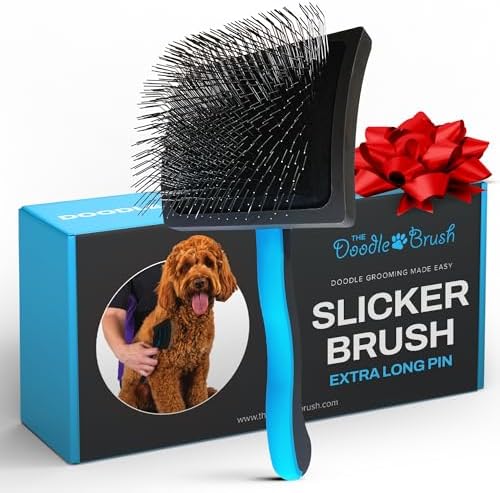A rake is similar to a pin brush but features longer pins. It’s an effective de-shedding tool designed to reach deep into the fur of heavy or double-coated dogs. Different types of brushes for dogs serve specific grooming purposes, and a rake is ideal for managing thick undercoats.
The pet grooming market is a booming industry, valued at over $9.9 billion, underscoring the importance of high-quality grooming tools. With so many options available, choosing the right brush for your dog’s coat type can make a significant difference. If you have a short-haired breed, using an effective fur removal brush for short-haired breeds helps minimise shedding and keeps their coat looking sleek and healthy.
7 Different Types of Brushes for Dogs
One of the most critical tools in dog grooming is the brush. Choosing the right brush for your dog’s coat type is vital for maintaining their coat and preventing issues like matting, tangles, and skin irritation. This guide will walk you through the various types of brushes for dogs, helping you select the best one for your furry friend.
1. Slicker Brush
A slicker brush is a versatile grooming tool with a flat or curved head. It features fine wire bristles that are angled and may have protective tips. These design elements help prevent the brush from irritating your dog’s skin, making it suitable for most breeds with medium to long hair.

- Slicker brushes are excellent for removing mats, tangles, and loose hair from your dog’s undercoat.
- They are particularly effective for breeds with longer or thicker coats.
- However, it’s essential to choose the right size for your dog and use a brush with a flexible handle to make grooming easier.
- Be gentle while brushing to avoid applying too much pressure, which can cause discomfort.
2. Pin Brush
A pin brush resembles the brushes used by humans. It is often round in shape and covered in wires with plastic tips at the ends. Different types of brushes for dogs serve various grooming needs, and pin brushes are gentle on thick and curly coats, making them ideal for medium to long-haired dogs.

- Pin brushes are best used as a finishing tool after your dog’s coat has been initially groomed with a stronger tool.
- They can clear minor knots and are particularly useful after bathing your dog.
- However, they are not ideal for removing large mats or tangles as they tend to get stuck.
3. Bristle Brush
Bristle brushes are an excellent complement to pin brushes and are particularly effective as finishing tools for dogs with short or wiry coats. They work by distributing natural oils throughout your dog’s coat, leaving it shiny and reducing shedding.

- The type of bristle brush you choose should depend on your dog’s coat length and texture.
- Long, soft bristles are better for dogs with long, silky coats, while short, tough bristles work well for short-haired dogs.
- Bristle brushes are also great for adding a final touch to your grooming routine, ensuring your dog’s coat looks polished and well-maintained.
4. Rakes
A rake is similar to a pin brush but features longer pins. It’s an effective de-shedding tool designed to reach deep into the fur of heavy or double-coated dogs. Different types of brushes for dogs serve various grooming needs, and a rake is ideal for managing thick undercoats and reducing shedding.
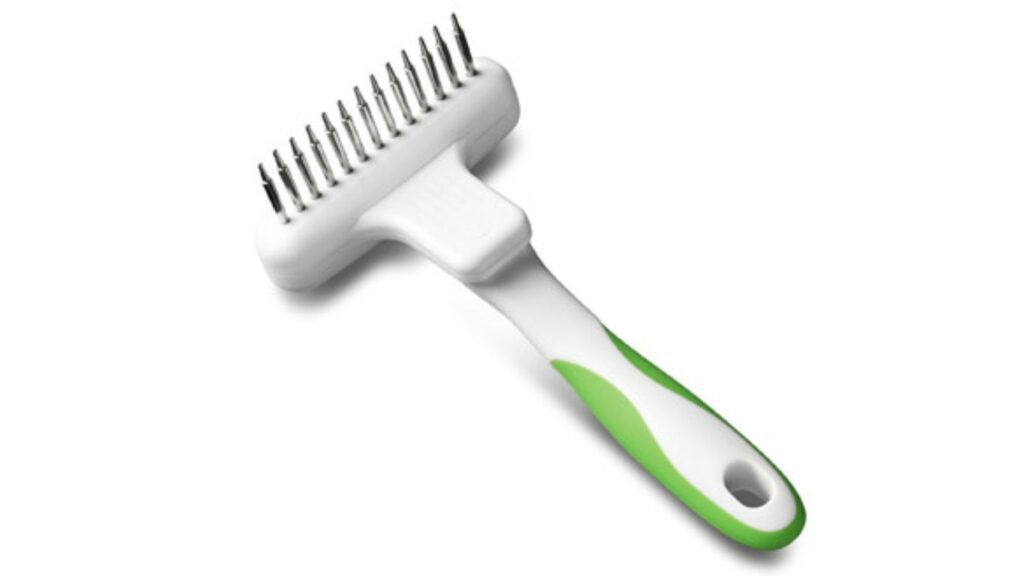
- Rakes are gentle yet powerful tools that remove dead fur, knots, and tangles from long-haired dogs.
- There are also undercoat rakes, which have small, curved blades designed to reach the undercoat of breeds such as German Shepherds, Pomeranians, and Huskies.
- It’s crucial to choose a rake with pins that match the length of your dog’s hair.
- Pins that are too short won’t reach the undercoat, while those that are too long could irritate your dog’s skin.
5. Rubber Brush
Rubber brushes, also known as curry combs, are small, handheld tools with rounded rubber knobs. They are gentle on your dog’s skin and can also be found in the form of grooming gloves.
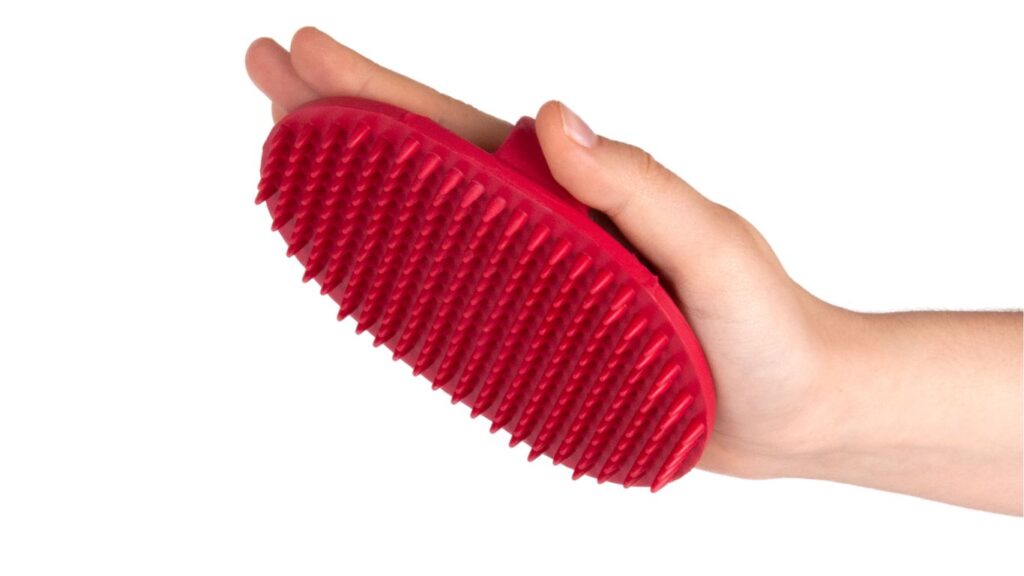
- Rubber brushes are ideal for dogs that are sensitive to grooming.
- The soft rubber knobs provide a gentle massage while removing loose hair and dirt from the coat.
- This type of brush is particularly beneficial for short-haired breeds and can make grooming a more pleasant experience for dogs that typically resist it.
6. Combs
Combs are essential finishing tools that can be used after brushing to remove any remaining debris, knots, or tangles. They help leave your dog’s coat shinier and smoother than brushing alone.
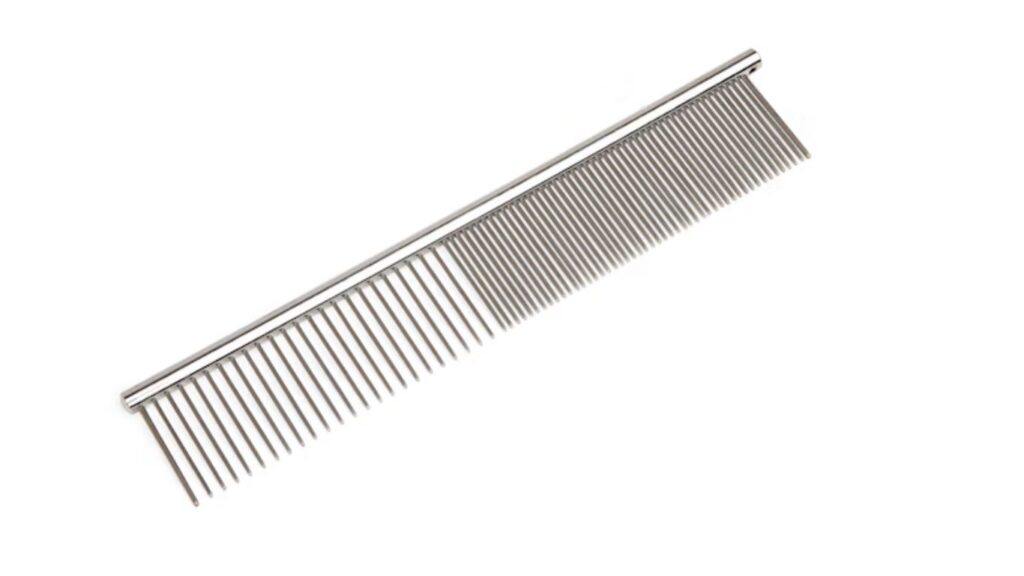
Types of Dog Combs
- General Use Combs: These resemble pin brushes but have teeth instead of wires. Combs with widely spaced teeth help remove knots and tangles, while those with tightly spaced teeth are better for finishing. They are best suited for dogs with long, thick hair and an undercoat.
- De-Matting Combs: Designed to cut out mats like a rake, these combs are best for dogs with heavy, thick coats. They can be a bit tricky to use due to their sharp blades, so it’s important to handle them carefully or seek advice from a professional groomer if you’re unsure.
- Flea Combs: These combs have finely spaced teeth that catch dirt and fleas, helping to keep your dog clean and healthy. They are especially useful after flea treatments to remove any remaining pests.
7. De-Shedding Tool Brushes
De-shedding brushes are designed to tackle shedding, which can be a major concern for certain breeds. These brushes don’t remove mats, but they are highly effective in gathering loose or dead hair before it reaches furniture and carpets.
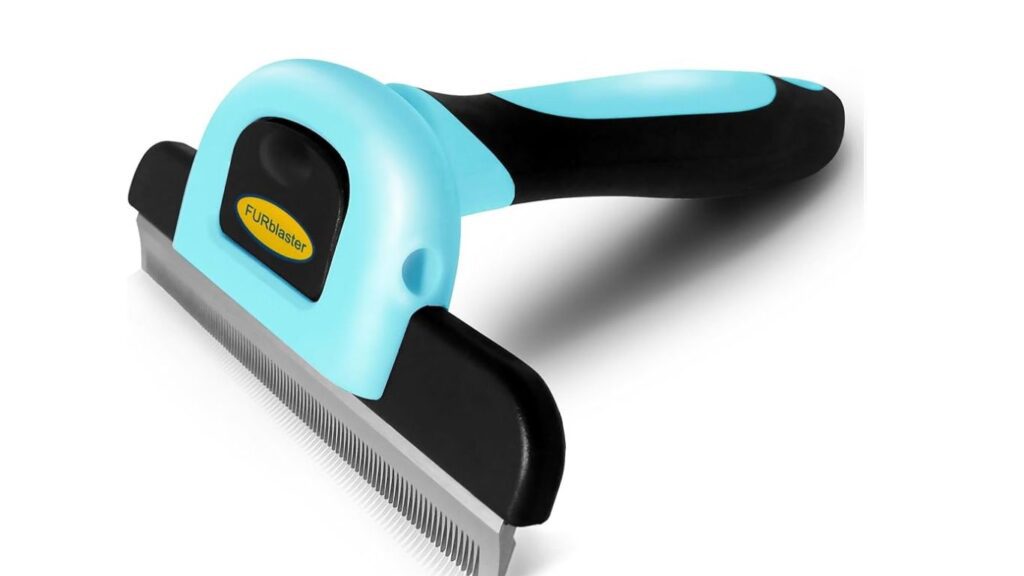
Breeds That Benefit from De-Shedding Brushes
While some dog breeds, like the Bichon Frise, Poodle, and Yorkshire Terrier, are known for minimal shedding, others, such as the Akita, Labrador Retriever, and Siberian Husky, tend to shed heavily. Managing excessive shedding can be challenging, but using top-rated de-shedding brushes for pets can significantly reduce loose fur and keep your home cleaner.
Finding the Right Dog Salon: Ensuring Your Dog’s Grooming Needs Are Met
Grooming is not just a cosmetic task; it is essential for your dog’s health and well-being. While at-home grooming is beneficial and often necessary, there are times when professional grooming is the best option, especially for dogs with complex coat types or those prone to matting and shedding.
Choosing the right dog salon is a crucial decision that can significantly impact your dog’s comfort, health, and overall grooming experience. This section will guide you through the process of finding a dog salon that meets your dog’s specific needs, ensuring that they receive the best care possible.
The Importance of Professional Grooming
Professional grooming services offer several advantages that go beyond what can typically be achieved at home. Experienced groomers have specialised knowledge and tools to handle various coat types and conditions. This expertise is particularly valuable for breeds with specific grooming requirements, such as double-coated breeds, dogs with long, silky hair, or those prone to matting. Understanding the factors affecting how fast a dog’s hair grows can also help pet owners manage grooming schedules more effectively.
A professional groomer can also identify potential health issues during the grooming process. For example, they can spot skin irritations, infections, or abnormal lumps that might go unnoticed by an untrained eye. Regular visits to a groomer can act as a preventive measure, catching problems early before they develop into more serious conditions.
Factors to Consider When Choosing a Dog Salon
When selecting a dog salon, there are several key factors to consider. Not all grooming salons are created equal, and choosing the right one involves more than just proximity to your home. Here’s what to look for:
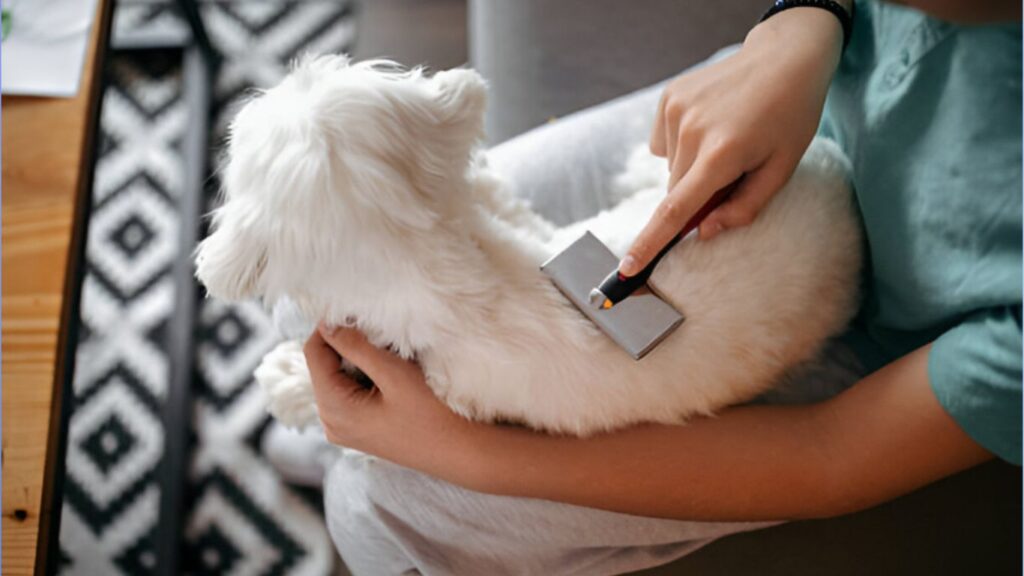
1. Reputation and Reviews
Start by researching local dog salons. Look for reviews online, ask for recommendations from friends or your veterinarian, and check social media pages for customer feedback. A salon with a strong reputation and positive reviews is often a good sign that they provide quality services. However, it’s essential to read reviews critically, paying attention to comments about how the salon handles dogs, the cleanliness of the facility, and the professionalism of the staff.
2. Experience and Expertise
Not all groomers have the same level of experience or expertise. Some may specialise in particular breeds or coat types, which can be an advantage if your dog has specific grooming needs. Ask about the groomers’ qualifications, training, and experience, especially if your dog requires specialised care, such as de-matting, hand-stripping, or dealing with sensitive skin. Experienced groomers are more likely to understand the nuances of different coat types and how to care for them effectively.
3. Range of Services
Different salons offer different services, so it’s essential to find one that can cater to your dog’s specific needs. Basic services typically include bathing, brushing, and nail trimming, but you may also need more specialised care, such as de-shedding treatments, ear cleaning, or teeth brushing. Some salons offer packages tailored to specific breeds or coat types, which can be a convenient option if your dog requires particular attention.
4. Hygiene and Cleanliness
Hygiene is crucial in any grooming environment. A clean salon reduces the risk of infections and ensures a pleasant experience for your dog. During your initial visit, take note of the cleanliness of the facility. The grooming tables, tools, and floors should be cleaned and sanitised regularly. Ask about their cleaning protocols, particularly how they disinfect brushes, combs, and other tools between uses to prevent the spread of bacteria or parasites.
5. Handling and Care
Your dog’s comfort and safety should be the top priority. Observe how the staff interacts with the dogs in their care. Do they handle the animals gently and with patience? Are they attentive to the dogs’ stress levels and needs? A good groomer will be skilled in making your dog feel comfortable, especially if your pet is anxious or nervous about grooming. They should also be knowledgeable about handling different temperaments, ensuring that the grooming process is as stress-free as possible.
6. Communication and Transparency
Effective communication is vital when choosing a groomer. A reputable salon will take the time to discuss your dog’s specific needs and any concerns you may have. They should provide a clear explanation of the services offered, including any additional costs for specialised treatments. Transparency is key, and a good groomer will be upfront about what to expect, including how long the grooming session will take and what you can do to prepare your dog beforehand.
Conclusion
Grooming is an essential aspect of caring for your dog, and using the right brush is key to maintaining a healthy coat. Whether you opt for a slicker brush to tackle tangles or a de-shedding brush to manage loose hair, selecting the appropriate types of brushes for dogs based on your dog’s coat type will make a significant difference. Regular grooming, combined with the right tools, will keep your dog’s coat looking its best and contribute to their overall well-being.
Read more: Explore the best brush for double-coated dogs to keep their thick fur well-groomed.



